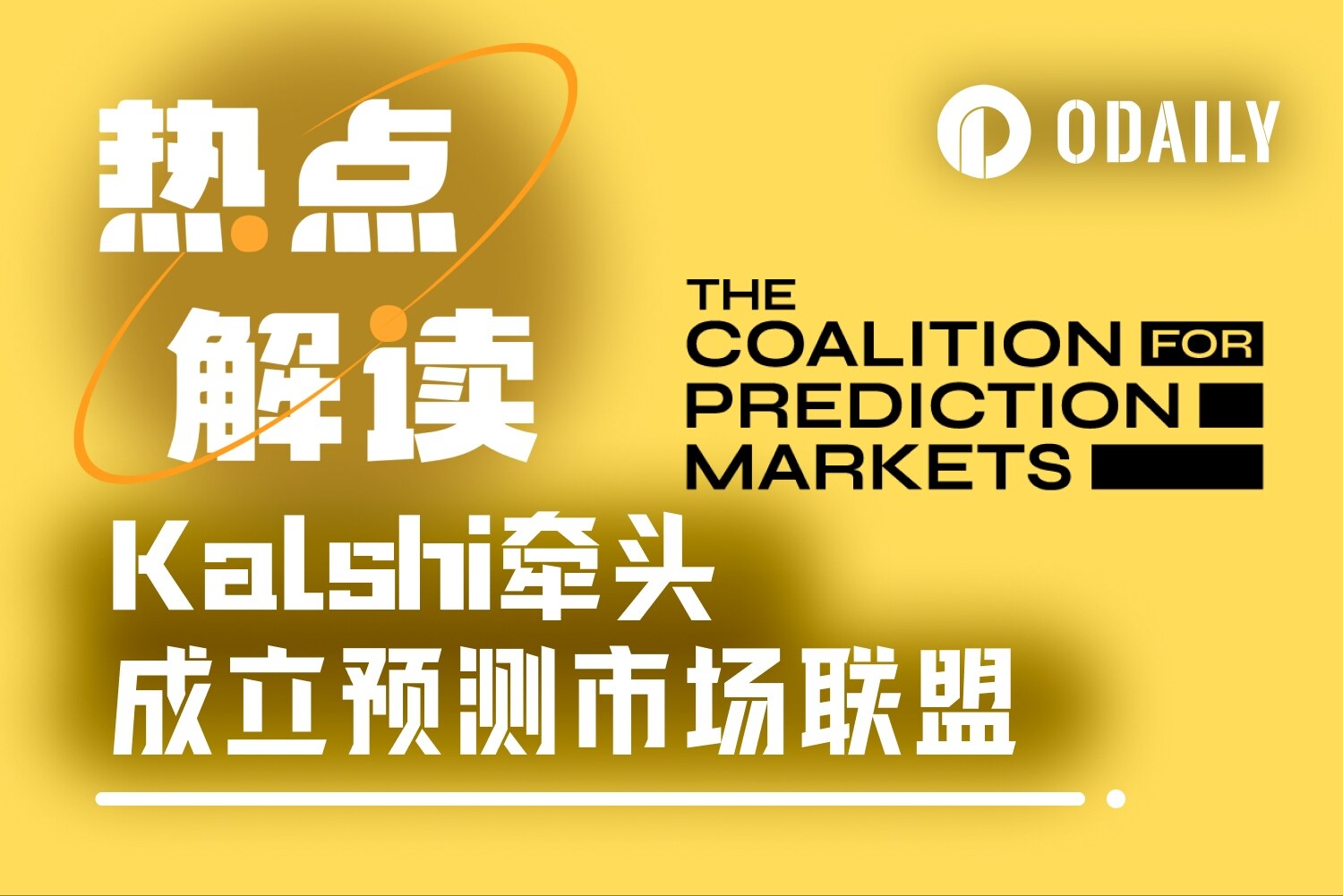DID, which is easily overlooked, is the passport to Web3
introduce
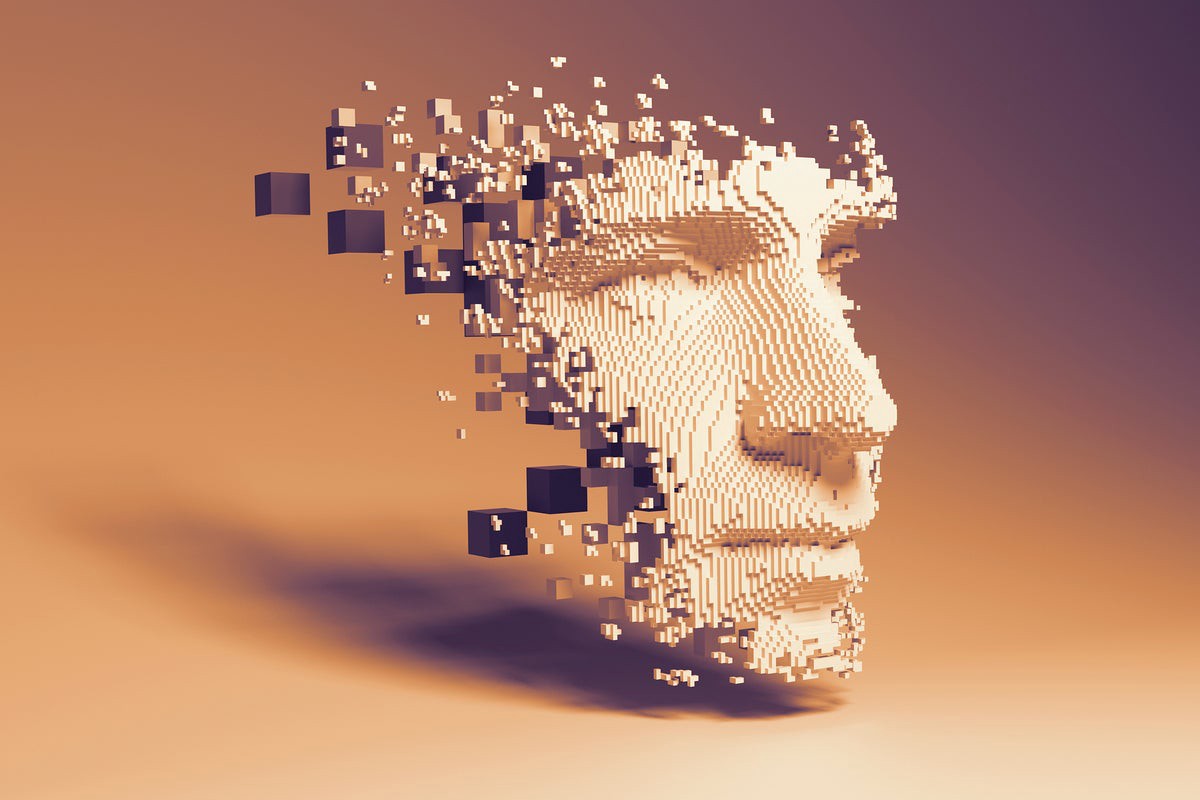
introduce
The internet was created without a native identity layer for people. Because of this, the question of digital identity is brought down to websites and apps. This siled approach may have been appropriate in the early days of the internet, but its shortcomings are becoming increasingly apparent as billions of people now go online. Usernames and passwords are still the dominant model, althoughProven repeatedly to be an unsafe pattern. on average everyone wantsHandles 70 to 80 passwordsandOkta、1PasswordandDashlane. Most importantly, users don't actually own their online identities. Instead, they rent from companies and centralized entities. As a result, they are vulnerable to digital identitieshacked、review、reviewor simplelostrisks of.
The emergence of Web3, with its fundamentally embedded economic shift, has brought renewed emphasis on creating strong identity systems. While decentralized identity (DID) is a largely overlooked topic compared to DeFi, NFTs, and DAOs, we see it as a key technical foundation for enabling Web3-native applications. If we create a shared, flexible, resilient identity layer, we can greatly unleash the pace of innovation by creating a broader design space.
first level title
Decentralized Identification (DID)
DID specification from W3Care widely accepted standards that ensure identity systems are interoperable across different networks and platforms.
secondary title
Basic Components of a DID Architecture
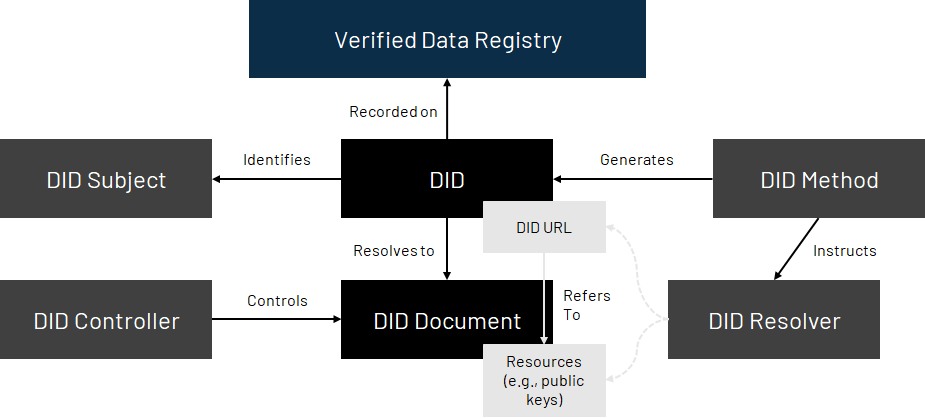
secondary title
first level title
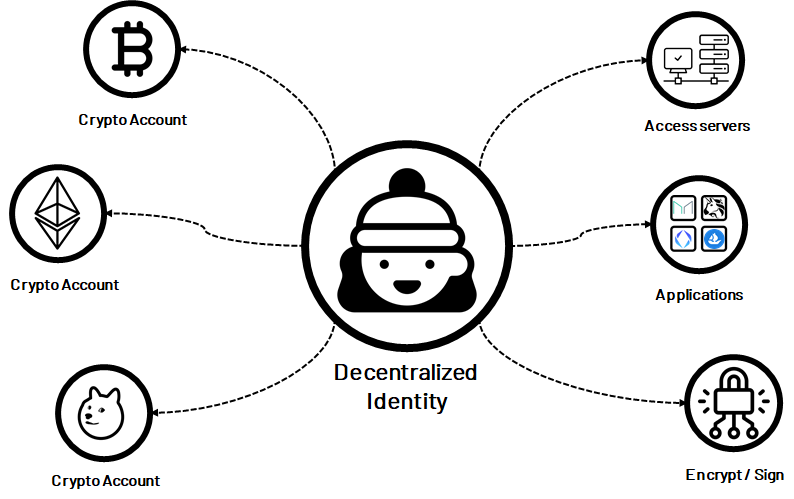
DIDs enable new use cases
In the physical world, identity is integral to a well-functioning society. Passports enable governments to identify their citizens, driver's licenses enable citizens to claim the right to be on the road, university degree-granting eligibility, and so on.
Likewise, DIDs will enable high-value Internet economic activities. Below, we highlight some of the current Web3 pain points that DIDs can solve.
NFTs - Authenticity and Identity
Fraud and plagiarism continue to plague artists and creators. For example, Derek Laufman, digital artist and designer for Marvel's Super Hero Adventures, seesHis work was auctioned off by NFT platform Rarible without his knowledge. stories like thisvery common。
(source:
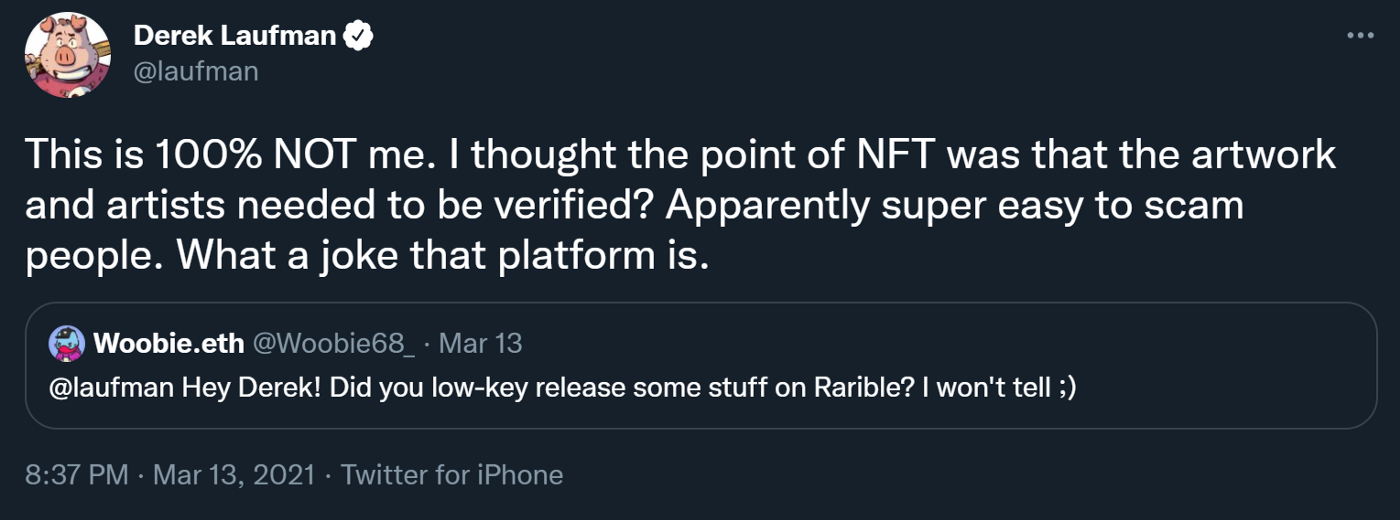
(source:twitter)
A strong DID infrastructure can solve this problem. Apps can be built on top of DIDs, allowing creators to prove that NFTs representing digital or physical assets were created by them. Buyers and sellers will also be able to verify the provenance of digital artwork. DIDs can also help facilitate greater engagement between artists and their communities, such as by restricting ownership of NFTs to community members to limit speculation by scalpers, or by providing exclusive NFT content to specific holders.
More broadly, NFTs can serve as an anchor for decentralized identities. There are already some users who identify their online presence not only with usernames but also with NFT items. As an example, Manifold co-founder @richerd explained that he rejectedA $9.5 million offer for his cypherpunk NFT, because he considers his cypherpunk his identity and brand.
image description
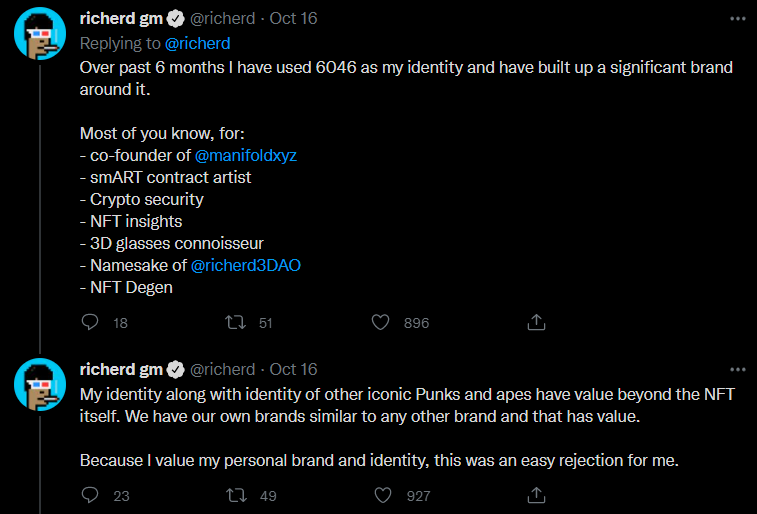
(Source: Twitter (@richerd))
Unlocking the next phase of DeFi
Mortgage lending has been the mainstay of DeFi growth so far. But since cryptocurrency financial protocols aim to be completely trustless and permissionless, they often require over-collateralization. For example, ETH issued on MakerDAOLoans require a mortgage rate of 130-170%. This has fueled the growth of DeFi over the past year, but collateral requirements have limited usage mostly to cryptocurrency traders looking to take on leverage. For most people, the reason they want to borrow is because they don't have the money they need yet.
chain"chain"Credit scoring, which provides users with credit-based loan opportunities. Additionally, since users have direct control over their credit scores, they can better monitor and adjust their lending behavior. Therefore, DID presents an opportunity to further democratize the decentralized financial system.
Additionally, having a strong identity layer in financial applications can solve other current problems in DeFi, such as:
Improve the fair distribution of token airdrops by verifying actual members and reducing the likelihood of bots diluting airdrop events.
Use DIDs to gate access to DeFi pools to mitigate spam/Sybil attacks, or to enable institutional participation by providing compliance tools to identify counterparties.
Guide users throughEthereum's Dark Forest, illuminating that participants can be trusted to act in a positive-sum manner.
Decentralized Autonomous Organization (DAO)
DAOs typically use token-based governance for voting, influence, and priority. This usually makes sense - a large number of token holders have the most skins in the game - but it can exclude or deprive priority of active contributors who may not have significant capital. While members can build their own reputations within a DAO, they may need to build their reputations from scratch in a new environment.
,existGitcoin,existMirrorPublish articles on or inRadicleDID Ecosystem
DID Ecosystem
The DID ecosystem can be broken down into several layers, each of which is built on top of the underlying protocol. We leveraged and slightly modifiedDIF's 4-tier identity modelimage description
Layered Decentralized Identity Ecosystem
text
Layer 1: Identifiers and Standards
Standards, identifiers, and namespaces create a common layer of trust, ensuring standardization, portability, and interoperability. They also allow the network to register and manage DID methods, providing developers and users with the rules and background of the network's ID system.
Decentralized Identity Foundation (DIF)text
Layer 2: Infrastructure (Infrustructure)
text
Layer 3: Credentials
Credentials must be managed, updated and exchanged. The purpose of this layer is to figure out how DIDs negotiate proofs of control and authentication, and securely pass data between identity owners.
BrightIDimage description
Vitalik Buterin on the potential applications of BrightID
textTwitter (@VitalikButerin))
Layer 4: Applications, Wallets, and Products (Apps, Wallets, and Products)
This layer is probably the most familiar to readers and intends to provide real-world use cases and value to consumers. some items likeGoldfinch(unsecured loans), using proprietary unique entity checks, but aiming to leverage decentralized ID solutions as they mature. In contrast, other applications already leverage existing DID technologies such asTrueFi(unsecured loans with on-chain credit scoring),Gitcoin(to finance public goods) andEssigntext
Layer X: Horizontal (Transversal)
These projects largely transcend any single layer and have impacts on multiple levels. For example, Europe's GDPR data protection law has implications for all areas of the ecosystem.
image description
first level title
secondary title
Ethereum Name Service - Public Archives for Ethereum
The Ethereum Name Service (ENS) is an underlying tool that will turn any Ethereum address into a public profile. Its main job is to map human-readable names to machine-readable identifiers. use it instead"0x7fc7a9694A09077e137f953108265ad59cCF5ba3 "To make a transaction, you can enter"amberfin.eth "to replace. And, because of the hierarchical nature of ENS, anyone who owns that domain name may also own a subdomain. For example, because Amber Group owns"amberfin.eth", which can also create"pay.mberfin.eth". ENS domain names can also have text records, which allows users to store a variety of data, all linked to only one identifier. In this setup, there is no centralized entity or company involved.
Amber Group’s ENS Records
The use cases for ENS continue to grow. A full DNS integration to ENS launched this August, so you can send your crypto to"example.com "instead of"example.eth". Additionally, .eth domains can also be used to build decentralized websites. For example, Ethereum co-founder Vitalik Buterin used this DNS integration with IPFS to create a robust, censorship-resistant websitehttps://vitalik.eth/。
secondary title
ENS Name and Avatar Support on Uniswap
ENS Ecosystem
On November 2, ENS announced that it isDecentralized governance by accepting applications from DAO representatives and airdropping $ENS governance tokens. The airdrop includes 25% of the total maximum supply; the remainder will go to community treasury and contributors. The distribution is basically giving half of the total tokens to people in the past (former contributors and users) and half to people in the future (community treasury).
ENS Token Distribution
$ENS token holders only hold the governance rights of the DAO and receive no additional monetary value. Unusually, $ENS token holders are required to signENS Constitution, which highlights key principles — such as enforcing property rights, avoiding rent-seeking behavior, and integrating with a global namespace — to claim their tokens. As such, one of the most exciting aspects of the $ENS token is that it is a grand experiment in how markets price digital public goods.
ENS has generated nearly $20 million in revenue, mostly from the registration of new domain names, which will go to the DAO treasury.
image description
(Source: Dune Analytics (@makoto))
ENS revenue per transaction also increased, indicating that users registered domain names for longer, acquired higher-value domain names (i.e., shorter-length domain names), or both.
image description
(Source: Dune Analytics (@makoto))
After hitting an intraday high of about $8.4 billion, ENS's fully-diluted market capitalization is currently [$4.2 billion], meaning it's based on a trailing 12-month price-to-earnings ratio of 236.
image description
(Source: CoinGecko)
Metamask - Gateway to Blockchain Applications
In a new technology paradigm, the solutions that users interact with most often have a huge impact on the future development of the industry. Similar to how browsers were the battleground for Web1 (Netscape, Internet Explorer, Google Chrome) and applications for Web2 (Facebook, Instagram, Netflix, Spotify), wallets may become the battleground for Web3.
If you've ever interacted with a Web3 application, chances are you've used Metamask. Launched by ConsenSys in 2016, Metamask is a non-custodial cryptocurrency wallet that allows users to interact with the Ethereum blockchain and any Ethereum-compatible network such as Polygon, Arbitrum, Avalanche.
While not strictly focused on decentralized identity, Metamask serves asMore than 21 million monthly active usersThe de facto app for accessing their Ethereum addresses. Parallel to the Web2 single sign-on (SSO) option, nearly all EVM-compliant Web3 applications will offer"Login with Metamask"。
Registration options for Augur (left) and OpenSea (right)
Metamask serves as a powerful mental model of what a broader DID solution might look like, while also emphasizing both the promise and the dangers of self-sovereignty. Since Metamask users hold their own private keys, they truly own the assets in their wallets. There is no need to trust third party security and custody. Additionally, users can seamlessly transfer assets from one application to another. For example, NFT purchased on SuperRare can be easily sold on OpenSea, limiting platform lock-in and enhancing portability. Arguably, the customer experience has also been improved — instead of having to deal with complex sign-up procedures and managing multiple usernames/passwords, users can simply connect their Metamask wallets to try new apps. And, although it seems"Connect with wallet"Seems fragmented, but it's important to remember that these wallets are just UI and all use the same basic account system - you can import your Web3 accounts to other wallets.
Import an account to Metamask
However, hacks and scams abound. Web3 users must be extremely vigilant about the security of their wallets so as not to lose control of all their assets. Even just losing your wallet's seed phrase can result in permanent loss of funds. Therefore, some users may still prefer to delegate account security and management to third-party custodians.
Metamask expects to gradually transition to decentralized governance. ConsenSys founder Joseph Lubin recently said that Metamask will launch a token in the near future. According to Erik Marks, a senior software engineer at Metamask, the project"Be absolutely open to ideas of making this project community-owned", though the team hopes the use case for the Metamask token will be convincing. Some have speculated that if Metamask does have an airdrop, users who have used Metamask's swap feature will be the main deciding factor.
image description
(source:Twitter (@ethereumJoseph))
Metamask primarily monetizes (monetizes) through its embedded swap functionality, which aggregates data from decentralized exchange aggregators, market makers, and DEXs, and adds a 0.85% swap fee on top of it. Adoption of the swap feature has grown significantly since the start of the year — Metamask earned roughly $40 million in swap fees from its swaps in the last month.
image description
(Source: Dune Analytics (@tomhschmidt))
In fact, the revenue growth of Metamask’s swap function significantly outpaced the revenue growth of Sushiswap and Curve.
image description
(Source: Dune Analytics (@momir))
image description
Liquidity source of Metamask Swap
(Source: Dune Analytics (@momir), November 21, 2021)
There is a wide range of potential valuations for Metamask tokens. Stock valuations are not directly comparable, but ConsenSys' recent equity raise ($200 million at a $3.2 billion valuation) can provide a rough estimate of what Metamask tokens might be worth (when Sky Mavis raised equity at a $3 billion valuation , AXS tokens are worth around $4-5 billion). The comparability of direct tokens also suggests a wide range. Applying a multiple of $500 to $1,000 per MAU suggests a potential valuation range of $10.5 billion to $21 billion.
image description
(Sources: Public filings, Capital IQ, CoinGecko, Amber Group estimates)
Ceramic
Ceramicis a public, decentralized data network for managing dynamic and variable information on the internet. It provides developers with the ability to build applications without databases or servers by creating a flexible primitive called Ceramic streams.
On Ceramic, each message is represented as an append-only commit log, called a stream. Each stream (stream) is a directed acyclic graph (DAG) stored in IPLD, has an immutable name called StreamID, and a verifiable state called StreamState. A stream is conceptually similar to a Git tree, and each stream can be thought of as its own blockchain, ledger, or event log. Tile Documents are a type of Ceramic StreamType and are often used as identity metadata (e.g. profiles, social graphs, linked social accounts), user-generated content (e.g. blog posts, social media), DID files, verifiable credentials, etc. database replacement.
The protocol does not rely on any particular blockchain. Instead, it can be conceptualized as a"document chain", where validating the status of a particular document only requires the user to sync the data for the given document. Users do not need to synchronize the state of the entire network like most blockchain networks (such as Bitcoin, Ethereum) usually do. Therefore, there is no global ledger of files.
One of the key tools of Ceramic isIDX, a cross-chain identity protocol that provides a unified repository where all applications can register and discover data sources related to a user's DID. It can be thought of as a decentralized user table. Thus, IDX allows users to control their identities and data without being locked into any single application, and to easily secure and port their data across applications. At the same time, it allows developers to build data-rich applications without forcing users to recreate the same data on each application.
Ceramic is an important middleware in the DID technology stack (stack). Several projects built on top of the Ceramic network have seen traction and market fit, including:
Boardroom: A DAO governance management platform that uses Ceramic's platform to store proposal comments.
Rabbithole: Apps that encourage people to use the Web3 project, allowing them to earn points and cryptocurrencies. Rabbithole uses Ceramic's network to connect multiple Web2 and Web3 accounts into a unified, cross-chain DID, and allows users' reputation to span other Web3 applications.
ArcX: a decentralized application by issuing"DeFi Passport"in conclusion
in conclusion
The Internet is perhaps the most important invention of this century. Over the past two decades, it has transformed the fundamental nature of the flow of information in society: media, politics, journalism, education, social interaction, and more. Yet even as economic activity increasingly moves from atoms to bytes, our online identities still lack true ownership and remain siled within platforms.
With the advent of the Internet of Value, robust DID solutions will be required to bring Web3 mainstream by enabling new use cases. We're still in the early days, but the future is bright. Due to the composability and interoperability of DID standards, the momentum generated by each new application will affect another application. We expect DID solutions to continue to grow exponentially in importance over the next few years and start the next major cycle of Web3 adoption.
Appendix 1: Beginner's Guide to ENS Domain Names
First, connect your wallet toENS application。
apply for registration"apply for registration"Enter
Enter"my account", to set up a reverse record. You can only have one primary ENS name per Ethereum address. Afterwards, any party that transacts with you can refer to your .eth address instead of your public key.
You can also click on your ENS domain name to modify the text record for your domain name. If you want to connect your own DNS registrar with your ENS name at the same time, the ENS Medium blog haspublished a guidedisclaimer
disclaimer
information"information") are prepared for informational purposes only, in summary form and are not meant to be complete. This information is not, and is not intended to be, an offer to sell or the solicitation of an offer to buy any securities. This information does not provide and should not be considered to provide investment advice. This information does not take into account the specific investment objectives, financial situation or particular needs of any potential investor. We make no representations or warranties, express or implied, as to the fairness, correctness, accuracy, adequacy or completeness of the information. We make no commitment to update this information. Potential investors should not consider this report a substitute for their own judgment or research. Potential investors should consult their own legal, regulatory, tax, business, investment, financial and accounting advisors to the extent they deem necessary and rely on their own judgment and the advice of such advisors as they deem necessary and not on the basis of this report any opinions expressed in making any investment decisions


